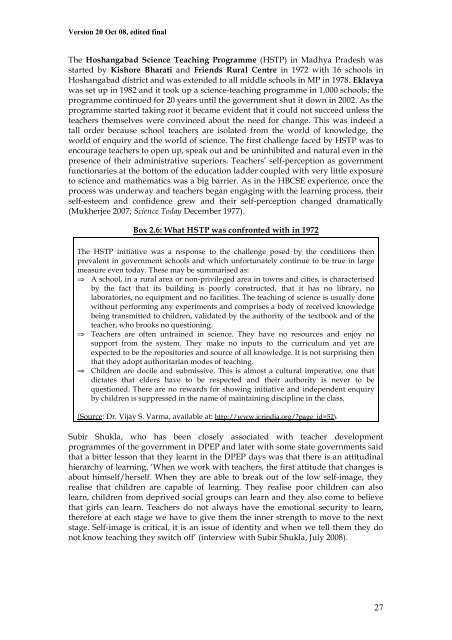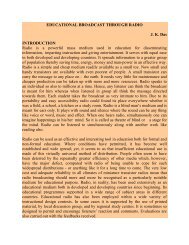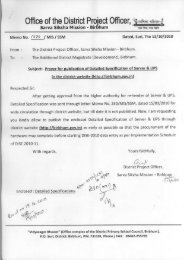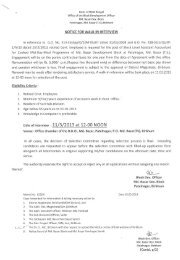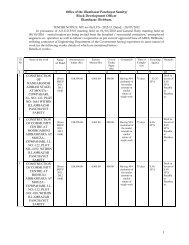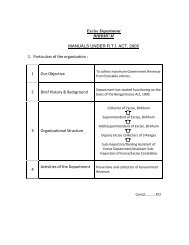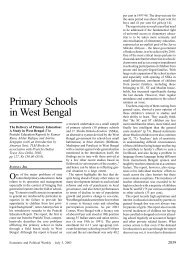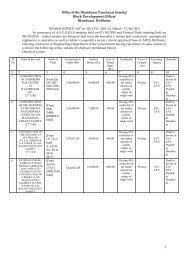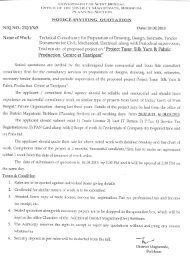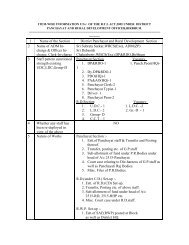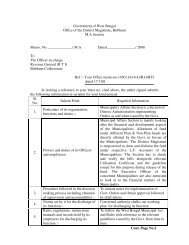primary school teachers the twists and turns of ... - ERU Consultants
primary school teachers the twists and turns of ... - ERU Consultants
primary school teachers the twists and turns of ... - ERU Consultants
Create successful ePaper yourself
Turn your PDF publications into a flip-book with our unique Google optimized e-Paper software.
Version 20 Oct 08, edited finalThe Hoshangabad Science Teaching Programme (HSTP) in Madhya Pradesh wasstarted by Kishore Bharati <strong>and</strong> Friends Rural Centre in 1972 with 16 <strong>school</strong>s inHoshangabad district <strong>and</strong> was extended to all middle <strong>school</strong>s in MP in 1978. Eklavyawas set up in 1982 <strong>and</strong> it took up a science-teaching programme in 1,000 <strong>school</strong>s; <strong>the</strong>programme continued for 20 years until <strong>the</strong> government shut it down in 2002. As <strong>the</strong>programme started taking root it became evident that it could not succeed unless <strong>the</strong><strong>teachers</strong> <strong>the</strong>mselves were convinced about <strong>the</strong> need for change. This was indeed atall order because <strong>school</strong> <strong>teachers</strong> are isolated from <strong>the</strong> world <strong>of</strong> knowledge, <strong>the</strong>world <strong>of</strong> enquiry <strong>and</strong> <strong>the</strong> world <strong>of</strong> science. The first challenge faced by HSTP was toencourage <strong>teachers</strong> to open up, speak out <strong>and</strong> be uninhibited <strong>and</strong> natural even in <strong>the</strong>presence <strong>of</strong> <strong>the</strong>ir administrative superiors. Teachers’ self-perception as governmentfunctionaries at <strong>the</strong> bottom <strong>of</strong> <strong>the</strong> education ladder coupled with very little exposureto science <strong>and</strong> ma<strong>the</strong>matics was a big barrier. As in <strong>the</strong> HBCSE experience, once <strong>the</strong>process was underway <strong>and</strong> <strong>teachers</strong> began engaging with <strong>the</strong> learning process, <strong>the</strong>irself-esteem <strong>and</strong> confidence grew <strong>and</strong> <strong>the</strong>ir self-perception changed dramatically(Mukherjee 2007; Science Today December 1977).Box 2.6: What HSTP was confronted with in 1972The HSTP initiative was a response to <strong>the</strong> challenge posed by <strong>the</strong> conditions <strong>the</strong>nprevalent in government <strong>school</strong>s <strong>and</strong> which unfortunately continue to be true in largemeasure even today. These may be summarised as:⇒ A <strong>school</strong>, in a rural area or non-privileged area in towns <strong>and</strong> cities, is characterisedby <strong>the</strong> fact that its building is poorly constructed, that it has no library, nolaboratories, no equipment <strong>and</strong> no facilities. The teaching <strong>of</strong> science is usually donewithout performing any experiments <strong>and</strong> comprises a body <strong>of</strong> received knowledgebeing transmitted to children, validated by <strong>the</strong> authority <strong>of</strong> <strong>the</strong> textbook <strong>and</strong> <strong>of</strong> <strong>the</strong>teacher, who brooks no questioning.⇒ Teachers are <strong>of</strong>ten untrained in science. They have no resources <strong>and</strong> enjoy nosupport from <strong>the</strong> system. They make no inputs to <strong>the</strong> curriculum <strong>and</strong> yet areexpected to be <strong>the</strong> repositories <strong>and</strong> source <strong>of</strong> all knowledge. It is not surprising <strong>the</strong>nthat <strong>the</strong>y adopt authoritarian modes <strong>of</strong> teaching.⇒ Children are docile <strong>and</strong> submissive. This is almost a cultural imperative, one thatdictates that elders have to be respected <strong>and</strong> <strong>the</strong>ir authority is never to bequestioned. There are no rewards for showing initiative <strong>and</strong> independent enquiryby children is suppressed in <strong>the</strong> name <strong>of</strong> maintaining discipline in <strong>the</strong> class.(Source: Dr. Vijay S. Varma, available at: http://www.icrindia.org/?page_id=52).Subir Shukla, who has been closely associated with teacher developmentprogrammes <strong>of</strong> <strong>the</strong> government in DPEP <strong>and</strong> later with some state governments saidthat a bitter lesson that <strong>the</strong>y learnt in <strong>the</strong> DPEP days was that <strong>the</strong>re is an attitudinalhierarchy <strong>of</strong> learning. ‘When we work with <strong>teachers</strong>, <strong>the</strong> first attitude that changes isabout himself/herself. When <strong>the</strong>y are able to break out <strong>of</strong> <strong>the</strong> low self-image, <strong>the</strong>yrealise that children are capable <strong>of</strong> learning. They realise poor children can alsolearn, children from deprived social groups can learn <strong>and</strong> <strong>the</strong>y also come to believethat girls can learn. Teachers do not always have <strong>the</strong> emotional security to learn,<strong>the</strong>refore at each stage we have to give <strong>the</strong>m <strong>the</strong> inner strength to move to <strong>the</strong> nextstage. Self-image is critical, it is an issue <strong>of</strong> identity <strong>and</strong> when we tell <strong>the</strong>m <strong>the</strong>y donot know teaching <strong>the</strong>y switch <strong>of</strong>f’ (interview with Subir Shukla, July 2008).27


